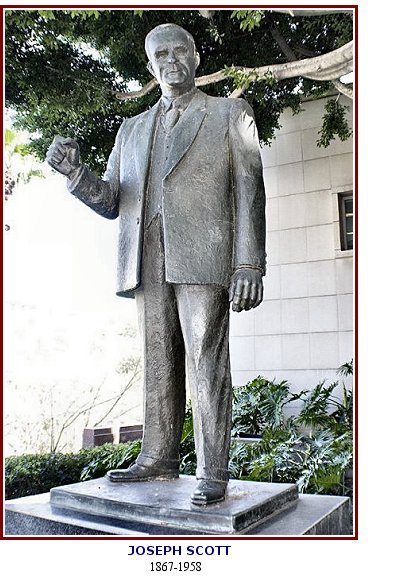Wednesday, December 24, 2008
Page 15
REMINISCING (Column)
Statue of Attorney Joseph Scott Is Shunted to the Rear
By ROGER M. GRACE
A friend of mine, who hales from Boston, commented to me recently that denizens of this burgh don’t seem to give a hoot about their area’s past. I think he’s right.
Historic presevation is not high on the list of priorities of the county or its cities, and the public has little awareness of the feats and failures of leaders of past eras.
The eight-foot bronze statue of an orator used to be positioned close to the sidewalk in front of the Grand Street entrance to the county’s main courthouse. Now, it’s been shoved back among the shrubs, attracting little attention. If anyone did notice the name on the pedestal—Joseph Scott—that name would be apt to have no meaning.

Yet, when he died in 1958, Scott—for decades known as “Mr. Los Angeles”—was hailed for contributions to Los Angeles of supreme magnitude.
The presiding judge of the Los Angeles Superior Court, Louis Burke (later a justice of the California Supreme Court), declared: “From the historian’s viewpoint, he will stand out as one of the top men of this century.”
E. Avery Crary, president of the Los Angeles County Bar Assn. (later a U.S. district judge) said: “He will ever be remembered as one of the greatest men to have resided in our area.”
He was a preeminent lawyer, founder of the Southwest Museum (and a member of its Board of Trustees for half a century), co-founder of the Los Angeles Chamber of Commerce, a founder of the Knights of Columbus in Southern California, a founder and later president of the Los Angeles Community Chest, the second dean of Loyola Law School, a multi-term president of the Los Angeles City school board. That’s a short list of Scott’s innumerable civic activities.
Yet, his statue is now so positioned as to connote relative unimportance.
It was Goodwin J. Knight, governor of California from 1953-59, who, starting in December 1962, led efforts to raise money from the private sector for the design and casting of the sculpture, and for the granite base. Co-chairing the Joseph Scott Memorial Committee was retired California Supreme Court Justice Thomas P. White.
The Board of Supervisors had given consent to placement of the statue outside the courthouse, but had declined to provide funding.
A $100-a-plate dinner was held Jan. 20, 1963 at the Beverly Hilton Hotel to aid the effort. More than 350 persons attended. That was the start.
The statue was unveiled on Oct. 11, 1967. The next day’s Valley News and Green Sheet observes:
“ ‘One of the Southland’s grand old men’ gazed from bronze eyes across the city he helped punch and prod from stumbling adolescence to bustling adulthood.”
A photo of the ceremony appears on the front page of the local section of the Times. In the shot are Knight, Bishop John Ward, and Joseph Scott III, the eldest of the civic leader’s 23 grandchildren.
JS III, now director of communications for District Attorney Steve Cooley, recalls that moving the statue from foregound to background had something to do with a widening of Grand Avenue.
Attorney/civic leader Joseph Scott deserves to be remembered. His statue should be restored to a place of prominence.
The current positioning demeans the man who is depicted, and betrays Governor Knight and the others who raised and/or provided funds with the assurance of the county that the statue would be enjoy a highly visible situs.
The courthouse and its grounds are now controlled by the state. The state should move the statue. Next week, I’ll offer a suggestion as to where it ought to go.
Copyright 2008, Metropolitan News Company